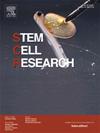一组携带敲入变异rs120074178 (KCNQ1 c.569G > a)的转基因长QT综合征诱导的多能干细胞系的产生p.Arg190Gln)和rs137854600 (SCN5A c.4865G > A;p.Arg1622Gln)和等基因控制系
IF 0.7
4区 医学
Q4 BIOTECHNOLOGY & APPLIED MICROBIOLOGY
引用次数: 0
摘要
长QT综合征(LQTS)是一种以危及生命的心律失常为特征的遗传性通道病。LQTS有许多由包含突变的基因定义的亚型,包括LQT1 (KCNQ1)、LQT2 (KCNH2)和LQT3 (SCN5A)。在这里,我们使用CRISPR/Cas9技术生成了5个等基因的人类诱导多能干细胞(iPSC)系,其中一个系含有LQT1变体rs120074178 (KCNQ1 c.569G >;A),两条线路包含LQT3变体rs137854600 (SCN5A c.4865G >;A),以及两条派生控制线。本文章由计算机程序翻译,如有差异,请以英文原文为准。
Generation of a set of genetically modified long QT syndrome induced pluripotent stem cell lines carrying knock-in variants rs120074178 (KCNQ1 c.569G > A; p.Arg190Gln) and rs137854600 (SCN5A c.4865G > A; p.Arg1622Gln) and isogenic control lines
Long QT syndrome (LQTS) is an inherited channelopathy characterized by life-threatening arrhythmias. LQTS has many subtypes defined by the gene that contains the mutation, including LQT1 (KCNQ1), LQT2 (KCNH2), and LQT3 (SCN5A). Here, we used CRISPR/Cas9 technology to generate five isogenic human induced pluripotent stem cell (iPSC) lines, one line harboring an LQT1 variant rs120074178 (KCNQ1 c.569G > A), two lines harboring an LQT3 variant rs137854600 (SCN5A c.4865G > A), and two derived control lines.
求助全文
通过发布文献求助,成功后即可免费获取论文全文。
去求助
来源期刊

Stem cell research
生物-生物工程与应用微生物
CiteScore
2.20
自引率
8.30%
发文量
338
审稿时长
55 days
期刊介绍:
Stem Cell Research is dedicated to publishing high-quality manuscripts focusing on the biology and applications of stem cell research. Submissions to Stem Cell Research, may cover all aspects of stem cells, including embryonic stem cells, tissue-specific stem cells, cancer stem cells, developmental studies, stem cell genomes, and translational research. Stem Cell Research publishes 6 issues a year.
 求助内容:
求助内容: 应助结果提醒方式:
应助结果提醒方式:


